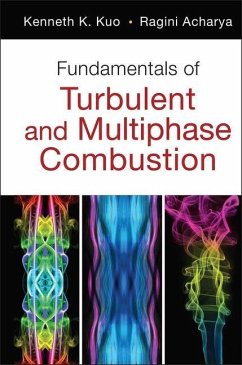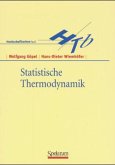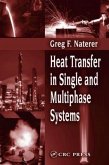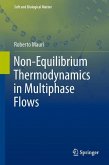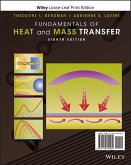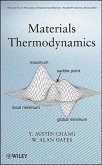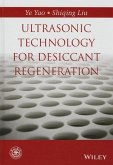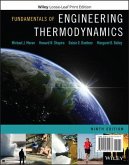- Gebundenes Buch
- Merkliste
- Auf die Merkliste
- Bewerten Bewerten
- Teilen
- Produkt teilen
- Produkterinnerung
- Produkterinnerung
Detailed coverage of advanced combustion topics from the author of Principles of combustion, Second Edition Turbulence, turbulent combustion, and multiphase reacting flows have become major research topics in recent decades due to their application across diverse fields, including energy, environment, propulsion, transportation, industrial safety, and nanotechnology. Most of the knowledge accumulated from this research has never been published in book form--until now. Fundamentals of Turbulent and Multiphase Combustion presents up-to-date, integrated coverage of the fundamentals of turbulence,…mehr
Andere Kunden interessierten sich auch für
![Statistische Thermodynamik Statistische Thermodynamik]() Wolfgang GöpelStatistische Thermodynamik64,99 €
Wolfgang GöpelStatistische Thermodynamik64,99 €![Heat Transfer in Single and Multiphase Systems Heat Transfer in Single and Multiphase Systems]() Greg F. NatererHeat Transfer in Single and Multiphase Systems325,99 €
Greg F. NatererHeat Transfer in Single and Multiphase Systems325,99 €![Non-Equilibrium Thermodynamics in Multiphase Flows Non-Equilibrium Thermodynamics in Multiphase Flows]() Roberto MauriNon-Equilibrium Thermodynamics in Multiphase Flows38,99 €
Roberto MauriNon-Equilibrium Thermodynamics in Multiphase Flows38,99 €![Fundamentals of Heat and Mass Transfer Fundamentals of Heat and Mass Transfer]() Theodore L BergmanFundamentals of Heat and Mass Transfer147,99 €
Theodore L BergmanFundamentals of Heat and Mass Transfer147,99 €![Materials Thermodynamics Materials Thermodynamics]() Y Austin ChangMaterials Thermodynamics122,99 €
Y Austin ChangMaterials Thermodynamics122,99 €![Ultrasonic Technology for Desiccant Regeneration Ultrasonic Technology for Desiccant Regeneration]() Ye YaoUltrasonic Technology for Desiccant Regeneration149,99 €
Ye YaoUltrasonic Technology for Desiccant Regeneration149,99 €![Fundamentals of Engineering Thermodynamics Fundamentals of Engineering Thermodynamics]() Michael J MoranFundamentals of Engineering Thermodynamics147,99 €
Michael J MoranFundamentals of Engineering Thermodynamics147,99 €-
-
-
Detailed coverage of advanced combustion topics from the author of Principles of combustion, Second Edition Turbulence, turbulent combustion, and multiphase reacting flows have become major research topics in recent decades due to their application across diverse fields, including energy, environment, propulsion, transportation, industrial safety, and nanotechnology. Most of the knowledge accumulated from this research has never been published in book form--until now. Fundamentals of Turbulent and Multiphase Combustion presents up-to-date, integrated coverage of the fundamentals of turbulence, combustion, and multiphase phenomena along with useful experimental techniques, including non-intrusive, laser-based measurement techniques, providing a firm background in both contemporary and classical approaches. Beginning with two full chapters on laminar premixed and non-premixed flames, this book takes a multiphase approach, beginning with more common topics and moving on to higher-level applications. In addition, Fundamentals of Turbulent and Multiphase Combustion * Addresses seven basic topical areas in combustion and multiphase flows, including laminar premixed and non-premixed flames, theory of turbulence, turbulent premixed and non-premixed flames, and multiphase flows * Covers spray atomization and combustion, solid-propellant combustion, homogeneous propellants, nitramines, reacting boundary-layer flows, single energetic particle combustion, and granular bed combustion * Provides experimental setups and results whenever appropriate Supported with a large number of examples and problems as well as a solutions manual, Fundamentals of Turbulent and Multiphase Combustion is an important resource for professional engineers and researchers as well as graduate students in mechanical, chemical, and aerospace engineering.
Produktdetails
- Produktdetails
- Verlag: Wiley
- Seitenzahl: 912
- Erscheinungstermin: 24. April 2012
- Englisch
- Abmessung: 236mm x 157mm x 51mm
- Gewicht: 1338g
- ISBN-13: 9780470226223
- ISBN-10: 0470226226
- Artikelnr.: 33870366
- Herstellerkennzeichnung
- Libri GmbH
- Europaallee 1
- 36244 Bad Hersfeld
- gpsr@libri.de
- Verlag: Wiley
- Seitenzahl: 912
- Erscheinungstermin: 24. April 2012
- Englisch
- Abmessung: 236mm x 157mm x 51mm
- Gewicht: 1338g
- ISBN-13: 9780470226223
- ISBN-10: 0470226226
- Artikelnr.: 33870366
- Herstellerkennzeichnung
- Libri GmbH
- Europaallee 1
- 36244 Bad Hersfeld
- gpsr@libri.de
KENNETH K. KUO is Distinguished Professor of Mechanical Engineering and Director of the High Pressure Combustion Laboratory (HPCL) in the Department of Mechanical and Nuclear Engineering of the College of Engineering at Pennsylvania State University. Professor Kuo established the HPCL and is recognized as one of the leading researchers and experts in propulsion-related combustion. RAGINI ACHARYA is Senior Research Scientist at United Technologies Research Center. She received her PhD from Pennsylvania State University in December, 2008. Dr. Acharya's research expertise includes development of multi-physics, multi-scale, multiphase models, fire dynamics, numerical methods, and scientific computing. She has authored or coauthored multiple technical articles in these areas.
Preface xix 1 Introduction and Conservation Equations 1 1.1 Why Is Turbulent and Multiphase Combustion Important?, 3 1.2 Different Applications for Turbulent and Multiphase Combustion, 3 1.2.1 Applications in High Rates of Combustion of Materials for Propulsion Systems, 5 1.2.2 Applications in Power Generation, 7 1.2.3 Applications in Process Industry, 7 1.2.4 Applications in Household and Industrial Heating, 7 1.2.5 Applications in Safety Protections for Unwanted Combustion, 7 1.2.6 Applications in Ignition of Various Combustible Materials, 8 1.2.7 Applications in Emission Control of Combustion Products, 8 1.2.8 Applications in Active Control of Combustion Processes, 8 1.3 Objectives of Combustion Modeling, 8 1.4 Combustion-Related Constituent Disciplines, 9 1.5 General Approach for Solving Combustion Problems, 9 1.6 Governing Equations for Combustion Models, 11 1.6.1 Conservation Equations, 11 1.6.2 Transport Equations, 11 1.6.3 Common Assumptions Made in Combustion Models, 11 1.6.4 Equation of State, 12 1.6.4.1 High-Pressure Correction, 13 1.7 Definitions of Concentrations, 14 1.8 Definitions of Energy and Enthalpy Forms, 16 1.9 Velocities of Chemical Species, 19 1.9.1 Definitions of Absolute and Relative Mass and Molar Fluxes, 20 1.10 Dimensionless Numbers, 23 1.11 Derivation of Species Mass Conservation Equation and Continuity Equation for Multicomponent Mixtures, 23 1.12 Momentum Conservation Equation for Mixture, 29 1.13 Energy Conservation Equation for Multicomponent Mixture, 33 1.14 Total Unknowns versus Governing Equations, 40 Homework Problems, 41 2 Laminar Premixed Flames 43 2.1 Basic Structure of One-Dimensional Premixed Laminar Flames, 46 2.2 Conservation Equations for One-Dimensional Premixed Laminar Flames, 47 2.2.1 Various Models for Diffusion Velocities, 49 2.2.1.1 Multicomponent Diffusion Velocities (First-Order Approximation), 49 2.2.1.2 Various Models for Describing Source Terms due to Chemical Reactions, 54 2.2.2 Sensitivity Analysis, 66 2.3 Analytical Relationships for Premixed Laminar Flames with a Global Reaction, 68 2.3.1 Three Analysis Procedures for Premixed Laminar Flames, 77 2.3.2 Generalized Expression for Laminar Flame Speeds, 80 2.3.2.1 Reduced Reaction Mechanism for HC-Air Flame, 81 2.3.3 Dependency of Laminar Flame Speed on Temperature and Pressure, 82 2.3.4 Premixed Laminar Flame Thickness, 84 2.4 Effect of Flame Stretch on Laminar Flame Speed, 86 2.4.1 Definitions of Stretch Factor and Karlovitz Number, 86 2.4.2 Governing Equation for Premixed Laminar Flame Surface Area, 94 2.4.3 Determination of Unstretched Premixed Laminar Flame Speeds and Markstein Lengths, 95 2.5 Modeling of Soot Formation in Laminar Premixed Flames, 103 2.5.1 Reaction Mechanisms for Soot Formation and Oxidation, 104 2.5.1.1 Empirical Models for Soot Formation, 106 2.5.1.2 Detailed Models for Soot Formation and Oxidation, 108 2.5.1.3 Formation of Aromatics, 109 2.5.1.4 Growth of Aromatics, 110 2.5.1.5 Migration Reactions, 112 2.5.1.6 Oxidation of Aromatics, 113 2.5.2 Mathematical Formulation of Soot Formation Model, 114 Homework Problems, 124 3 Laminar Non-Premixed Flames 125 3.1 Basic Structure of Non-Premixed Laminar Flames, 128 3.2 Flame Sheet Model, 129 3.3 Mixture Fraction Definition and Examples, 130 3.3.1 Balance Equations for Element Mass Fractions, 134 3.3.2 Temperature-Mixture Fraction Relationship, 138 3.4 Flamelet Structure of a Diffusion Flame, 142 3.4.1 Physical Significance of the Instantaneous Scalar Dissipation Rate, 145 3.4.2 Steady-State Combustion and Critical Scalar Dissipation Rate, 147 3.5 Time and Length Scales in Diffusion Flames, 151 3.6 Examples of Laminar Diffusion Flames, 153 3.6.1 Unsteady Mixing Layer, 153 3.6.2 Counterflow Diffusion Flames, 155 3.6.3 Coflow Diffusion Flame or Jet Flames, 165 3.7 Soot Formation in Laminar Diffusion Flames, 172 3.7.1 Soot Formation Model, 173 3.7.1.1 Particle Inception, 174 3.7.1.2 Surface Growth and Oxidation, 174 3.7.2 Appearance of Soot, 175 3.7.3 Experimental Studies by Using Coflow Burners, 176 3.7.3.1 Sooting Zone, 178 3.7.3.2 Effect of Fuel Structure, 182 3.7.3.3 Influence of Additives, 183 3.7.3.4 Coflow Ethylene/Air Laminar Diffusion Flames, 186 3.7.3.5 Modeling of Soot Formation, 191 Homework Problems, 204 4 Background in Turbulent Flows 206 4.1 Characteristics of Turbulent Flows, 210 4.1.1 Some Pictures, 212 4.2 Statistical Understanding of Turbulence, 213 4.2.1 Ensemble Averaging, 214 4.2.2 Time Averaging, 215 4.2.3 Spatial Averaging, 215 4.2.4 Statistical Moments, 215 4.2.5 Homogeneous Turbulence, 216 4.2.6 Isotropic Turbulence, 217 4.3 Conventional Averaging Methods, 217 4.3.1 Reynolds Averaging, 218 4.3.1.1 Correlation Functions, 222 4.3.2 Favre Averaging, 225 4.3.3 Relation between Time Averaged-Quantities and Mass-Weighted Averaged Quantities, 227 4.3.4 Mass-Weighted Conservation and Transport Equations, 228 4.3.4.1 Continuity and Momentum Equations, 228 4.3.4.2 Energy Equation, 230 4.3.4.3 Mean Kinetic Energy Equation, 231 4.3.4.4 Reynolds-Stress Transport Equations, 232 4.3.4.5 Turbulence-Kinetic-Energy Equation, 234 4.3.4.6 Turbulent Dissipation Rate Equation, 236 4.3.4.7 Species Mass Conservation Equation, 242 4.3.5 Vorticity Equation, 243 4.3.6 Relationship between Enstrophy and the Turbulent Dissipation Rate, 246 4.4 Turbulence Models, 247 4.5 Probability Density Function, 249 4.5.1 Distribution Function, 250 4.5.2 Joint Probability Density Function, 252 4.5.3 Bayes' Theorem, 254 4.6 Turbulent Scales, 256 4.6.1 Comment on Kolmogorov Hypotheses, 260 4.7 Large Eddy Simulation, 266 4.7.1 Filtering, 268 4.7.2 Filtered Momentum Equations and Subgrid Scale Stresses, 270 4.7.3 Modeling of Subgrid-Scale Stress Tensors, 274 4.8 Direct Numerical Simulation, 279 Homework Problems, 280 5 Turbulent Premixed Flames 283 5.1 Physical Interpretation, 289 5.2 Some Early Studies in Correlation Development, 291 5.2.1 Damk
ohler's Analysis (1940), 292 5.2.2 Schelkin's Analysis (1943), 295 5.2.3 Karlovitz, Denniston, and Wells's Analysis (1951), 296 5.2.4 Summerfield's Analysis (1955), 297 5.2.5 Kovasznay's Characteristic Time Approach (1956), 298 5.2.6 Limitations of the Preceding Approaches, 299 5.3 Characteristic Scale of Wrinkles in Turbulent Premixed Flames, 304 5.3.1 Schlieren Photographs, 305 5.3.2 Observations on the Structure of Wrinkled Laminar Flames, 305 5.3.3 Measurements of Scales of Unburned and Burned Gas Lumps, 307 5.3.4 Length Scale of Wrinkles, 310 5.4 Development of Borghi Diagram for Premixed Turbulent Flames, 310 5.4.1 Physical Interpretation of Various Regimes in Borghi's Diagram, 311 5.4.1.1 Wrinkled Flame Regime, 311 5.4.1.2 Wrinkled Flame with Pockets Regime (also Called Corrugated Flame Regime), 311 5.4.1.3 Thickened Wrinkled Flames, 313 5.4.1.4 Thickened Flames with Possible Extinctions/Thick Flames, 314 5.4.2 Klimov-Williams Criterion, 314 5.4.3 Construction of Borghi Diagram, 316 5.4.3.1 Thick Flames (or Distributed Reaction Zone or Well-Stirred Reaction Zone), 318 5.4.4 Wrinkled Flames, 318 5.4.4.1 Wrinkled Flamelets (Weak Turbulence), 320 5.4.4.2 Corrugated Flamelets (Strong Turbulence), 322 5.5 Measurements in Premixed Turbulent Flames, 324 5.6 Eddy-Break-up Model, 324 5.6.1 Spalding's EBU Model, 335 5.6.2 Magnussen and Hjertager's EBU Model, 336 5.7 Intermittency, 337 5.8 Flame-Turbulence Interaction, 339 5.8.1 Effects of Flame on Turbulence, 341 5.9 Bray-Moss-Libby Model, 342 5.9.1 Governing Equations, 349 5.9.2 Gradient Transport, 353 5.9.3 Countergradient Transport, 354 5.9.4 Closure of Transport Terms, 357 5.9.4.1 Gradient Closure, 357 5.9.4.2 BML Closure, 358 5.9.5 Effect of Pressure Fluctuations Gradients, 361 5.9.6 Summary of DNS Results, 364 5.10 Turbulent Combustion Modeling Approaches, 368 5.11 Geometrical Description of Turbulent Premixed Flames and G-Equation, 368 5.11.1 Level Set Approach for the Corrugated Flamelets Regime, 371 5.11.2 Level Set Approach for the Thin Reaction Zone Regime, 374 5.12 Scales in Turbulent Combustion, 376 5.13 Closure of Chemical Reaction Source Term, 380 5.14 Probability Density Function Approach to Turbulent Combustion, 381 5.14.1 Derivation of the Transport Equation for Probability Density Function, 386 5.14.2 Moment Equations and PDF Equations, 391 5.14.3 Lagrangian Equations for Fluid Particles, 392 5.14.4 Gradient Transport Model in Composition PDF Method, 395 5.14.5 Determination of Overall Reaction Rate, 397 5.14.6 Lagrangian Monte Carlo Particle Methods, 398 5.14.7 Filtered Density Function Approach, 398 5.14.8 Prospect of PDF Methods, 399 Homework Problems, 400 Project No. 1, 400 Project No. 2, 401 6 Non-premixed Turbulent Flames 402 6.1 Major Issues in Non-premixed Turbulent Flames, 404 6.2 Turbulent Damk
ohler number, 406 6.3 Turbulent Reynolds Number, 407 6.4 Scales in Non-premixed Turbulent Flames, 407 6.4.1 Direct Numerical Simulation and Scales, 411 6.5 Turbulent Non-premixed Combustion Regime Diagram, 414 6.6 Turbulent Non-premixed Target Flames, 418 6.6.1 Simple Jet Flames, 419 6.6.1.1 CH4/H2/N2 Jet Flame, 420 6.6.1.2 Effect of Jet Velocity, 430 6.6.2 Piloted Jet Flames, 432 6.6.2.1 Comparison of Simple Jet Flame and Sandia Flames D and F, 448 6.6.3 Bluff Body Flames, 452 6.6.4 Swirl Stabilized Flames, 455 6.7 Turbulence-Chemistry Interaction, 456 6.7.1 Infinite Chemistry Assumption, 456 6.7.1.1 Unity Lewis Number, 457 6.7.1.2 Nonunity Lewis Number, 458 6.7.2 Finite-Rate Chemistry, 458 6.8 Probability Density Approach for Turbulent Non-premixed Combustion, 462 6.8.1 Physical Models, 465 6.8.2 Turbulent Transport in Velocity-Composition Pdf Methods, 466 6.8.2.1 Stochastic Mixing Model, 467 6.8.2.2 Stochastic Reorientation Model, 468 6.8.3 Molecular Transport and Scalar Mixing Models, 469 6.8.3.1 Interaction by Exchange with the Mean Model, 471 6.8.3.2 Modified Curl Mixing Model, 471 6.8.3.3 Euclidean Minimum Spanning Tree Model, 472 6.9 Flamelet Models, 476 6.9.1 Laminar Flamelet Assumption, 477 6.9.2 Unsteady Flamelet Modeling, 478 6.9.3 Flamelet Models and PDF, 479 6.10 Interactions of Flame and Vortices, 480 6.10.1 Flame Rolled Up in a Single Vortex, 482 6.10.2 Flame in a Shear Layer, 483 6.10.3 Jet Flames, 483 6.10.4 K
arm
an Vortex Street/V-Shaped Flame Interaction, 484 6.10.5 Burning Vortex Ring, 484 6.10.6 Head-on Flame/Vortex Interaction, 485 6.10.7 Experimental Setups for Flame/Vortex Interaction Studies, 486 6.10.7.1 Reaction Front/Vortex Interaction in Liquids, 486 6.10.7.2 Jet Flames, 487 6.10.7.3 Counterflow Diffusion Flames, 488 6.11 Generation and Dissipation of Vorticity Effects, 492 6.12 Non-premixed Flame-Vortex Interaction Combustion Diagram, 493 6.13 Flame Instability in Non-premixed Turbulent Flames, 496 6.14 Partially Premixed Flames or Edge Flames, 500 6.14.1 Formation of Edge Flames, 501 6.14.2 Triple Flame Stabilization of Lifted Diffusion Flame, 502 6.14.3 Analysis of Edge Flames, 503 Homework Problems, 506 Project No. 6.1, 506 Project No. 6.2, 507 Project No. 6.3, 507 7 Background in Multiphase flows with Reactions 509 7.1 Classification of Multiphase Flow Systems, 512 7.2 Practical Problems Involving Multiphase Systems, 514 7.3 Homogeneous versus Multi-component/Multiphase Mixtures, 515 7.4 CFD and Multiphase Simulation, 516 7.5 Averaging Methods, 520 7.5.1 Eulerian Average-Eulerian Mean Values, 522 7.5.2 Lagrangian Average-Lagrangian Mean Values, 523 7.5.3 Boltzmann Statistical Average, 524 7.5.4 Anderson and Jackson's Averaging for Dense Fluidized Beds, 525 7.6 Local Instant Formulation, 533 7.7 Eulerian-Eulerian Modeling, 536 7.7.1 Fluid-Fluid Modeling, 536 7.7.1.1 Closure Models, 538 7.7.2 Fluid-Solid Modeling, 540 7.7.2.1 Closure Models, 541 7.7.2.2 Dense Particle Flows, 547 7.7.2.3 Dilute Particle Flows, 549 7.8 Eulerian-Lagrangian Modeling, 550 7.8.1 Fluid-Solid Modeling, 551 7.8.1.1 Fluid Phase, 551 7.8.1.2 Solid Phase, 552 7.9 Interfacial Transport (Jump Conditions), 555 7.10 Interface-Tracking/Capturing, 561 7.10.1 Interface Tracking, 563 7.10.1.1 Markers on Interface (Surface Marker Techniques), 564 7.10.1.2 Surface-Fitted Method, 567 7.10.2 Interface Capturing, 568 7.10.2.1 Markers in Fluid (MAC Formulation), 568 7.10.2.2 Volume of Fluid Method, 569 7.11 Discrete Particle Methods, 573 Homework Problems, 575 8 Spray Atomization and Combustion 576 8.1 Introduction to Spray Combustion, 578 8.2 Spray-Combustion Systems, 580 8.3 Fuel Atomization, 582 8.3.1 Injector Types, 582 8.3.2 Atomization Characteristics, 584 8.4 Spray Statistics, 584 8.4.1 Particle Characterization, 584 8.4.2 Distribution Function, 585 8.4.2.1 Logarithmic Probability Distribution Function, 588 8.4.2.2 Rosin-Rammler Distribution Function, 588 8.4.2.3 Nukiyama-Tanasawa Distribution Function, 589 8.4.2.4 Upper-Limit Distribution Function of Mugele and Evans, 589 8.4.3 Transport Equation of the Distribution Function, 590 8.4.4 Simplified Spray Combustion Model for Liquid-Fuel Rocket Engines, 591 8.5 Spray Combustion Characteristics, 594 8.6 Classification of Models Developed for Spray Combustion Processes, 602 8.6.1 Simple Correlations, 602 8.6.2 Droplet Ballistic Models, 603 8.6.3 One-Dimensional Models, 603 8.6.4 Stirred-Reactor Models, 604 8.6.5 Locally Homogeneous-Flow Models, 605 8.6.6 Two-Phase-Flow (Dispersed-Flow) Models, 605 8.7 Locally Homogeneous Flow Models, 605 8.7.1 Classification of LHF Models, 606 8.7.2 Mathematical Formulation of LHF Models, 609 8.7.2.1 Basic Assumptions, 609 8.7.2.2 Equation of State, 609 8.7.2.3 Conservation Equations, 615 8.7.2.4 Turbulent Transport Equations, 619 8.7.2.5 Boundary Conditions, 620 8.7.2.6 Solution Procedures, 620 8.7.2.7 Comparison of LHF-Model Predictions with Experimental Data, 626 8.8 Two-Phase-Flow (Dispersed-Flow) Models, 634 8.8.1 Particle-Source-in-Cell Model (Discrete-Droplet Model), 637 8.8.1.1 Models for Single Drop Behavior, 639 8.8.2 Drop Breakup Process and Mechanism, 654 8.8.2.1 Drop Breakup Process, 654 8.8.2.2 Multi-component Droplet Breakup by Microexplosion, 659 8.8.3 Deterministic Discrete Droplet Models, 662 8.8.3.1 Gas-Phase Treatment in DDDMs, 664 8.8.3.2 Liquid-Phase Treatment in DDDMs, 666 8.8.3.3 Results of DDDMs, 667 8.8.4 Stochastic Discrete Droplet Models, 669 8.8.5 Comparison of Results between DDDMs and SDDMs, 671 8.8.6 Dense Sprays, 682 8.8.6.1 Introduction, 682 8.8.6.2 Background, 684 8.8.6.3 Jet Breakup Models, 690 8.8.6.4 Impinging Jet Atomization, 699 8.9 Group-Combustion Models of Chiu, 700 8.9.1 Group-Combustion Numbers, 701 8.9.2 Modes of Group Burning in Spray Flames, 703 8.10 Droplet Collison, 706 8.10.1 Droplet-Droplet Collisions, 707 8.10.2 Droplet-Wall Collision, 708 8.10.3 Interacting Droplet in a Many-Droplet System, 710 8.11 Optical Techniques for Particle Size Measurements, 710 8.11.1 Types of Optical Particle Sizing Methods, 711 8.11.2 Single Particle Counting Methods, 711 8.11.2.1 Scattering Ratio Technique, 712 8.11.2.2 Intensity Deconvolution Method, 713 8.11.2.3 Interferometric Method (Phase-Shift Method), 713 8.11.2.4 Visibility Method Using a Laser Doppler Velocimeter LDV, 713 8.11.2.5 Phase Doppler Sizing Anemometer, 713 8.11.3 Ensemble Particle Sizing Techniques, 714 8.11.3.1 Extinction Measurement Techniques, 714 8.11.3.2 Multiple Angle Scattering Technique, 714 8.11.3.3 Fraunhofer Diffraction Particle Analyzer, 715 8.11.3.4 Integral Transform Solutions for Near-Forward Scattering, 716 8.12 Effect of Droplet Spacing on Spray Combustion, 717 8.12.1 Evaporation and Combustion of Droplet Arrays, 717 Homework Problems, 720 Appendix A: Useful Vector and Tensor Operations 723 Appendix B: Constants and Conversion Factors Often Used in Combustion 751 Appendix C: Naming of Hydrocarbons 755 Appendix D: Detailed Gas-Phase Reaction Mechanism for Aromatics Formation 759 Appendix E: Particle Size-U.S. Sieve Size and Tyler Screen Mesh Equivalents 795 Bibliography 799 Index 869
ohler's Analysis (1940), 292 5.2.2 Schelkin's Analysis (1943), 295 5.2.3 Karlovitz, Denniston, and Wells's Analysis (1951), 296 5.2.4 Summerfield's Analysis (1955), 297 5.2.5 Kovasznay's Characteristic Time Approach (1956), 298 5.2.6 Limitations of the Preceding Approaches, 299 5.3 Characteristic Scale of Wrinkles in Turbulent Premixed Flames, 304 5.3.1 Schlieren Photographs, 305 5.3.2 Observations on the Structure of Wrinkled Laminar Flames, 305 5.3.3 Measurements of Scales of Unburned and Burned Gas Lumps, 307 5.3.4 Length Scale of Wrinkles, 310 5.4 Development of Borghi Diagram for Premixed Turbulent Flames, 310 5.4.1 Physical Interpretation of Various Regimes in Borghi's Diagram, 311 5.4.1.1 Wrinkled Flame Regime, 311 5.4.1.2 Wrinkled Flame with Pockets Regime (also Called Corrugated Flame Regime), 311 5.4.1.3 Thickened Wrinkled Flames, 313 5.4.1.4 Thickened Flames with Possible Extinctions/Thick Flames, 314 5.4.2 Klimov-Williams Criterion, 314 5.4.3 Construction of Borghi Diagram, 316 5.4.3.1 Thick Flames (or Distributed Reaction Zone or Well-Stirred Reaction Zone), 318 5.4.4 Wrinkled Flames, 318 5.4.4.1 Wrinkled Flamelets (Weak Turbulence), 320 5.4.4.2 Corrugated Flamelets (Strong Turbulence), 322 5.5 Measurements in Premixed Turbulent Flames, 324 5.6 Eddy-Break-up Model, 324 5.6.1 Spalding's EBU Model, 335 5.6.2 Magnussen and Hjertager's EBU Model, 336 5.7 Intermittency, 337 5.8 Flame-Turbulence Interaction, 339 5.8.1 Effects of Flame on Turbulence, 341 5.9 Bray-Moss-Libby Model, 342 5.9.1 Governing Equations, 349 5.9.2 Gradient Transport, 353 5.9.3 Countergradient Transport, 354 5.9.4 Closure of Transport Terms, 357 5.9.4.1 Gradient Closure, 357 5.9.4.2 BML Closure, 358 5.9.5 Effect of Pressure Fluctuations Gradients, 361 5.9.6 Summary of DNS Results, 364 5.10 Turbulent Combustion Modeling Approaches, 368 5.11 Geometrical Description of Turbulent Premixed Flames and G-Equation, 368 5.11.1 Level Set Approach for the Corrugated Flamelets Regime, 371 5.11.2 Level Set Approach for the Thin Reaction Zone Regime, 374 5.12 Scales in Turbulent Combustion, 376 5.13 Closure of Chemical Reaction Source Term, 380 5.14 Probability Density Function Approach to Turbulent Combustion, 381 5.14.1 Derivation of the Transport Equation for Probability Density Function, 386 5.14.2 Moment Equations and PDF Equations, 391 5.14.3 Lagrangian Equations for Fluid Particles, 392 5.14.4 Gradient Transport Model in Composition PDF Method, 395 5.14.5 Determination of Overall Reaction Rate, 397 5.14.6 Lagrangian Monte Carlo Particle Methods, 398 5.14.7 Filtered Density Function Approach, 398 5.14.8 Prospect of PDF Methods, 399 Homework Problems, 400 Project No. 1, 400 Project No. 2, 401 6 Non-premixed Turbulent Flames 402 6.1 Major Issues in Non-premixed Turbulent Flames, 404 6.2 Turbulent Damk
ohler number, 406 6.3 Turbulent Reynolds Number, 407 6.4 Scales in Non-premixed Turbulent Flames, 407 6.4.1 Direct Numerical Simulation and Scales, 411 6.5 Turbulent Non-premixed Combustion Regime Diagram, 414 6.6 Turbulent Non-premixed Target Flames, 418 6.6.1 Simple Jet Flames, 419 6.6.1.1 CH4/H2/N2 Jet Flame, 420 6.6.1.2 Effect of Jet Velocity, 430 6.6.2 Piloted Jet Flames, 432 6.6.2.1 Comparison of Simple Jet Flame and Sandia Flames D and F, 448 6.6.3 Bluff Body Flames, 452 6.6.4 Swirl Stabilized Flames, 455 6.7 Turbulence-Chemistry Interaction, 456 6.7.1 Infinite Chemistry Assumption, 456 6.7.1.1 Unity Lewis Number, 457 6.7.1.2 Nonunity Lewis Number, 458 6.7.2 Finite-Rate Chemistry, 458 6.8 Probability Density Approach for Turbulent Non-premixed Combustion, 462 6.8.1 Physical Models, 465 6.8.2 Turbulent Transport in Velocity-Composition Pdf Methods, 466 6.8.2.1 Stochastic Mixing Model, 467 6.8.2.2 Stochastic Reorientation Model, 468 6.8.3 Molecular Transport and Scalar Mixing Models, 469 6.8.3.1 Interaction by Exchange with the Mean Model, 471 6.8.3.2 Modified Curl Mixing Model, 471 6.8.3.3 Euclidean Minimum Spanning Tree Model, 472 6.9 Flamelet Models, 476 6.9.1 Laminar Flamelet Assumption, 477 6.9.2 Unsteady Flamelet Modeling, 478 6.9.3 Flamelet Models and PDF, 479 6.10 Interactions of Flame and Vortices, 480 6.10.1 Flame Rolled Up in a Single Vortex, 482 6.10.2 Flame in a Shear Layer, 483 6.10.3 Jet Flames, 483 6.10.4 K
arm
an Vortex Street/V-Shaped Flame Interaction, 484 6.10.5 Burning Vortex Ring, 484 6.10.6 Head-on Flame/Vortex Interaction, 485 6.10.7 Experimental Setups for Flame/Vortex Interaction Studies, 486 6.10.7.1 Reaction Front/Vortex Interaction in Liquids, 486 6.10.7.2 Jet Flames, 487 6.10.7.3 Counterflow Diffusion Flames, 488 6.11 Generation and Dissipation of Vorticity Effects, 492 6.12 Non-premixed Flame-Vortex Interaction Combustion Diagram, 493 6.13 Flame Instability in Non-premixed Turbulent Flames, 496 6.14 Partially Premixed Flames or Edge Flames, 500 6.14.1 Formation of Edge Flames, 501 6.14.2 Triple Flame Stabilization of Lifted Diffusion Flame, 502 6.14.3 Analysis of Edge Flames, 503 Homework Problems, 506 Project No. 6.1, 506 Project No. 6.2, 507 Project No. 6.3, 507 7 Background in Multiphase flows with Reactions 509 7.1 Classification of Multiphase Flow Systems, 512 7.2 Practical Problems Involving Multiphase Systems, 514 7.3 Homogeneous versus Multi-component/Multiphase Mixtures, 515 7.4 CFD and Multiphase Simulation, 516 7.5 Averaging Methods, 520 7.5.1 Eulerian Average-Eulerian Mean Values, 522 7.5.2 Lagrangian Average-Lagrangian Mean Values, 523 7.5.3 Boltzmann Statistical Average, 524 7.5.4 Anderson and Jackson's Averaging for Dense Fluidized Beds, 525 7.6 Local Instant Formulation, 533 7.7 Eulerian-Eulerian Modeling, 536 7.7.1 Fluid-Fluid Modeling, 536 7.7.1.1 Closure Models, 538 7.7.2 Fluid-Solid Modeling, 540 7.7.2.1 Closure Models, 541 7.7.2.2 Dense Particle Flows, 547 7.7.2.3 Dilute Particle Flows, 549 7.8 Eulerian-Lagrangian Modeling, 550 7.8.1 Fluid-Solid Modeling, 551 7.8.1.1 Fluid Phase, 551 7.8.1.2 Solid Phase, 552 7.9 Interfacial Transport (Jump Conditions), 555 7.10 Interface-Tracking/Capturing, 561 7.10.1 Interface Tracking, 563 7.10.1.1 Markers on Interface (Surface Marker Techniques), 564 7.10.1.2 Surface-Fitted Method, 567 7.10.2 Interface Capturing, 568 7.10.2.1 Markers in Fluid (MAC Formulation), 568 7.10.2.2 Volume of Fluid Method, 569 7.11 Discrete Particle Methods, 573 Homework Problems, 575 8 Spray Atomization and Combustion 576 8.1 Introduction to Spray Combustion, 578 8.2 Spray-Combustion Systems, 580 8.3 Fuel Atomization, 582 8.3.1 Injector Types, 582 8.3.2 Atomization Characteristics, 584 8.4 Spray Statistics, 584 8.4.1 Particle Characterization, 584 8.4.2 Distribution Function, 585 8.4.2.1 Logarithmic Probability Distribution Function, 588 8.4.2.2 Rosin-Rammler Distribution Function, 588 8.4.2.3 Nukiyama-Tanasawa Distribution Function, 589 8.4.2.4 Upper-Limit Distribution Function of Mugele and Evans, 589 8.4.3 Transport Equation of the Distribution Function, 590 8.4.4 Simplified Spray Combustion Model for Liquid-Fuel Rocket Engines, 591 8.5 Spray Combustion Characteristics, 594 8.6 Classification of Models Developed for Spray Combustion Processes, 602 8.6.1 Simple Correlations, 602 8.6.2 Droplet Ballistic Models, 603 8.6.3 One-Dimensional Models, 603 8.6.4 Stirred-Reactor Models, 604 8.6.5 Locally Homogeneous-Flow Models, 605 8.6.6 Two-Phase-Flow (Dispersed-Flow) Models, 605 8.7 Locally Homogeneous Flow Models, 605 8.7.1 Classification of LHF Models, 606 8.7.2 Mathematical Formulation of LHF Models, 609 8.7.2.1 Basic Assumptions, 609 8.7.2.2 Equation of State, 609 8.7.2.3 Conservation Equations, 615 8.7.2.4 Turbulent Transport Equations, 619 8.7.2.5 Boundary Conditions, 620 8.7.2.6 Solution Procedures, 620 8.7.2.7 Comparison of LHF-Model Predictions with Experimental Data, 626 8.8 Two-Phase-Flow (Dispersed-Flow) Models, 634 8.8.1 Particle-Source-in-Cell Model (Discrete-Droplet Model), 637 8.8.1.1 Models for Single Drop Behavior, 639 8.8.2 Drop Breakup Process and Mechanism, 654 8.8.2.1 Drop Breakup Process, 654 8.8.2.2 Multi-component Droplet Breakup by Microexplosion, 659 8.8.3 Deterministic Discrete Droplet Models, 662 8.8.3.1 Gas-Phase Treatment in DDDMs, 664 8.8.3.2 Liquid-Phase Treatment in DDDMs, 666 8.8.3.3 Results of DDDMs, 667 8.8.4 Stochastic Discrete Droplet Models, 669 8.8.5 Comparison of Results between DDDMs and SDDMs, 671 8.8.6 Dense Sprays, 682 8.8.6.1 Introduction, 682 8.8.6.2 Background, 684 8.8.6.3 Jet Breakup Models, 690 8.8.6.4 Impinging Jet Atomization, 699 8.9 Group-Combustion Models of Chiu, 700 8.9.1 Group-Combustion Numbers, 701 8.9.2 Modes of Group Burning in Spray Flames, 703 8.10 Droplet Collison, 706 8.10.1 Droplet-Droplet Collisions, 707 8.10.2 Droplet-Wall Collision, 708 8.10.3 Interacting Droplet in a Many-Droplet System, 710 8.11 Optical Techniques for Particle Size Measurements, 710 8.11.1 Types of Optical Particle Sizing Methods, 711 8.11.2 Single Particle Counting Methods, 711 8.11.2.1 Scattering Ratio Technique, 712 8.11.2.2 Intensity Deconvolution Method, 713 8.11.2.3 Interferometric Method (Phase-Shift Method), 713 8.11.2.4 Visibility Method Using a Laser Doppler Velocimeter LDV, 713 8.11.2.5 Phase Doppler Sizing Anemometer, 713 8.11.3 Ensemble Particle Sizing Techniques, 714 8.11.3.1 Extinction Measurement Techniques, 714 8.11.3.2 Multiple Angle Scattering Technique, 714 8.11.3.3 Fraunhofer Diffraction Particle Analyzer, 715 8.11.3.4 Integral Transform Solutions for Near-Forward Scattering, 716 8.12 Effect of Droplet Spacing on Spray Combustion, 717 8.12.1 Evaporation and Combustion of Droplet Arrays, 717 Homework Problems, 720 Appendix A: Useful Vector and Tensor Operations 723 Appendix B: Constants and Conversion Factors Often Used in Combustion 751 Appendix C: Naming of Hydrocarbons 755 Appendix D: Detailed Gas-Phase Reaction Mechanism for Aromatics Formation 759 Appendix E: Particle Size-U.S. Sieve Size and Tyler Screen Mesh Equivalents 795 Bibliography 799 Index 869
Preface xix 1 Introduction and Conservation Equations 1 1.1 Why Is Turbulent and Multiphase Combustion Important?, 3 1.2 Different Applications for Turbulent and Multiphase Combustion, 3 1.2.1 Applications in High Rates of Combustion of Materials for Propulsion Systems, 5 1.2.2 Applications in Power Generation, 7 1.2.3 Applications in Process Industry, 7 1.2.4 Applications in Household and Industrial Heating, 7 1.2.5 Applications in Safety Protections for Unwanted Combustion, 7 1.2.6 Applications in Ignition of Various Combustible Materials, 8 1.2.7 Applications in Emission Control of Combustion Products, 8 1.2.8 Applications in Active Control of Combustion Processes, 8 1.3 Objectives of Combustion Modeling, 8 1.4 Combustion-Related Constituent Disciplines, 9 1.5 General Approach for Solving Combustion Problems, 9 1.6 Governing Equations for Combustion Models, 11 1.6.1 Conservation Equations, 11 1.6.2 Transport Equations, 11 1.6.3 Common Assumptions Made in Combustion Models, 11 1.6.4 Equation of State, 12 1.6.4.1 High-Pressure Correction, 13 1.7 Definitions of Concentrations, 14 1.8 Definitions of Energy and Enthalpy Forms, 16 1.9 Velocities of Chemical Species, 19 1.9.1 Definitions of Absolute and Relative Mass and Molar Fluxes, 20 1.10 Dimensionless Numbers, 23 1.11 Derivation of Species Mass Conservation Equation and Continuity Equation for Multicomponent Mixtures, 23 1.12 Momentum Conservation Equation for Mixture, 29 1.13 Energy Conservation Equation for Multicomponent Mixture, 33 1.14 Total Unknowns versus Governing Equations, 40 Homework Problems, 41 2 Laminar Premixed Flames 43 2.1 Basic Structure of One-Dimensional Premixed Laminar Flames, 46 2.2 Conservation Equations for One-Dimensional Premixed Laminar Flames, 47 2.2.1 Various Models for Diffusion Velocities, 49 2.2.1.1 Multicomponent Diffusion Velocities (First-Order Approximation), 49 2.2.1.2 Various Models for Describing Source Terms due to Chemical Reactions, 54 2.2.2 Sensitivity Analysis, 66 2.3 Analytical Relationships for Premixed Laminar Flames with a Global Reaction, 68 2.3.1 Three Analysis Procedures for Premixed Laminar Flames, 77 2.3.2 Generalized Expression for Laminar Flame Speeds, 80 2.3.2.1 Reduced Reaction Mechanism for HC-Air Flame, 81 2.3.3 Dependency of Laminar Flame Speed on Temperature and Pressure, 82 2.3.4 Premixed Laminar Flame Thickness, 84 2.4 Effect of Flame Stretch on Laminar Flame Speed, 86 2.4.1 Definitions of Stretch Factor and Karlovitz Number, 86 2.4.2 Governing Equation for Premixed Laminar Flame Surface Area, 94 2.4.3 Determination of Unstretched Premixed Laminar Flame Speeds and Markstein Lengths, 95 2.5 Modeling of Soot Formation in Laminar Premixed Flames, 103 2.5.1 Reaction Mechanisms for Soot Formation and Oxidation, 104 2.5.1.1 Empirical Models for Soot Formation, 106 2.5.1.2 Detailed Models for Soot Formation and Oxidation, 108 2.5.1.3 Formation of Aromatics, 109 2.5.1.4 Growth of Aromatics, 110 2.5.1.5 Migration Reactions, 112 2.5.1.6 Oxidation of Aromatics, 113 2.5.2 Mathematical Formulation of Soot Formation Model, 114 Homework Problems, 124 3 Laminar Non-Premixed Flames 125 3.1 Basic Structure of Non-Premixed Laminar Flames, 128 3.2 Flame Sheet Model, 129 3.3 Mixture Fraction Definition and Examples, 130 3.3.1 Balance Equations for Element Mass Fractions, 134 3.3.2 Temperature-Mixture Fraction Relationship, 138 3.4 Flamelet Structure of a Diffusion Flame, 142 3.4.1 Physical Significance of the Instantaneous Scalar Dissipation Rate, 145 3.4.2 Steady-State Combustion and Critical Scalar Dissipation Rate, 147 3.5 Time and Length Scales in Diffusion Flames, 151 3.6 Examples of Laminar Diffusion Flames, 153 3.6.1 Unsteady Mixing Layer, 153 3.6.2 Counterflow Diffusion Flames, 155 3.6.3 Coflow Diffusion Flame or Jet Flames, 165 3.7 Soot Formation in Laminar Diffusion Flames, 172 3.7.1 Soot Formation Model, 173 3.7.1.1 Particle Inception, 174 3.7.1.2 Surface Growth and Oxidation, 174 3.7.2 Appearance of Soot, 175 3.7.3 Experimental Studies by Using Coflow Burners, 176 3.7.3.1 Sooting Zone, 178 3.7.3.2 Effect of Fuel Structure, 182 3.7.3.3 Influence of Additives, 183 3.7.3.4 Coflow Ethylene/Air Laminar Diffusion Flames, 186 3.7.3.5 Modeling of Soot Formation, 191 Homework Problems, 204 4 Background in Turbulent Flows 206 4.1 Characteristics of Turbulent Flows, 210 4.1.1 Some Pictures, 212 4.2 Statistical Understanding of Turbulence, 213 4.2.1 Ensemble Averaging, 214 4.2.2 Time Averaging, 215 4.2.3 Spatial Averaging, 215 4.2.4 Statistical Moments, 215 4.2.5 Homogeneous Turbulence, 216 4.2.6 Isotropic Turbulence, 217 4.3 Conventional Averaging Methods, 217 4.3.1 Reynolds Averaging, 218 4.3.1.1 Correlation Functions, 222 4.3.2 Favre Averaging, 225 4.3.3 Relation between Time Averaged-Quantities and Mass-Weighted Averaged Quantities, 227 4.3.4 Mass-Weighted Conservation and Transport Equations, 228 4.3.4.1 Continuity and Momentum Equations, 228 4.3.4.2 Energy Equation, 230 4.3.4.3 Mean Kinetic Energy Equation, 231 4.3.4.4 Reynolds-Stress Transport Equations, 232 4.3.4.5 Turbulence-Kinetic-Energy Equation, 234 4.3.4.6 Turbulent Dissipation Rate Equation, 236 4.3.4.7 Species Mass Conservation Equation, 242 4.3.5 Vorticity Equation, 243 4.3.6 Relationship between Enstrophy and the Turbulent Dissipation Rate, 246 4.4 Turbulence Models, 247 4.5 Probability Density Function, 249 4.5.1 Distribution Function, 250 4.5.2 Joint Probability Density Function, 252 4.5.3 Bayes' Theorem, 254 4.6 Turbulent Scales, 256 4.6.1 Comment on Kolmogorov Hypotheses, 260 4.7 Large Eddy Simulation, 266 4.7.1 Filtering, 268 4.7.2 Filtered Momentum Equations and Subgrid Scale Stresses, 270 4.7.3 Modeling of Subgrid-Scale Stress Tensors, 274 4.8 Direct Numerical Simulation, 279 Homework Problems, 280 5 Turbulent Premixed Flames 283 5.1 Physical Interpretation, 289 5.2 Some Early Studies in Correlation Development, 291 5.2.1 Damk
ohler's Analysis (1940), 292 5.2.2 Schelkin's Analysis (1943), 295 5.2.3 Karlovitz, Denniston, and Wells's Analysis (1951), 296 5.2.4 Summerfield's Analysis (1955), 297 5.2.5 Kovasznay's Characteristic Time Approach (1956), 298 5.2.6 Limitations of the Preceding Approaches, 299 5.3 Characteristic Scale of Wrinkles in Turbulent Premixed Flames, 304 5.3.1 Schlieren Photographs, 305 5.3.2 Observations on the Structure of Wrinkled Laminar Flames, 305 5.3.3 Measurements of Scales of Unburned and Burned Gas Lumps, 307 5.3.4 Length Scale of Wrinkles, 310 5.4 Development of Borghi Diagram for Premixed Turbulent Flames, 310 5.4.1 Physical Interpretation of Various Regimes in Borghi's Diagram, 311 5.4.1.1 Wrinkled Flame Regime, 311 5.4.1.2 Wrinkled Flame with Pockets Regime (also Called Corrugated Flame Regime), 311 5.4.1.3 Thickened Wrinkled Flames, 313 5.4.1.4 Thickened Flames with Possible Extinctions/Thick Flames, 314 5.4.2 Klimov-Williams Criterion, 314 5.4.3 Construction of Borghi Diagram, 316 5.4.3.1 Thick Flames (or Distributed Reaction Zone or Well-Stirred Reaction Zone), 318 5.4.4 Wrinkled Flames, 318 5.4.4.1 Wrinkled Flamelets (Weak Turbulence), 320 5.4.4.2 Corrugated Flamelets (Strong Turbulence), 322 5.5 Measurements in Premixed Turbulent Flames, 324 5.6 Eddy-Break-up Model, 324 5.6.1 Spalding's EBU Model, 335 5.6.2 Magnussen and Hjertager's EBU Model, 336 5.7 Intermittency, 337 5.8 Flame-Turbulence Interaction, 339 5.8.1 Effects of Flame on Turbulence, 341 5.9 Bray-Moss-Libby Model, 342 5.9.1 Governing Equations, 349 5.9.2 Gradient Transport, 353 5.9.3 Countergradient Transport, 354 5.9.4 Closure of Transport Terms, 357 5.9.4.1 Gradient Closure, 357 5.9.4.2 BML Closure, 358 5.9.5 Effect of Pressure Fluctuations Gradients, 361 5.9.6 Summary of DNS Results, 364 5.10 Turbulent Combustion Modeling Approaches, 368 5.11 Geometrical Description of Turbulent Premixed Flames and G-Equation, 368 5.11.1 Level Set Approach for the Corrugated Flamelets Regime, 371 5.11.2 Level Set Approach for the Thin Reaction Zone Regime, 374 5.12 Scales in Turbulent Combustion, 376 5.13 Closure of Chemical Reaction Source Term, 380 5.14 Probability Density Function Approach to Turbulent Combustion, 381 5.14.1 Derivation of the Transport Equation for Probability Density Function, 386 5.14.2 Moment Equations and PDF Equations, 391 5.14.3 Lagrangian Equations for Fluid Particles, 392 5.14.4 Gradient Transport Model in Composition PDF Method, 395 5.14.5 Determination of Overall Reaction Rate, 397 5.14.6 Lagrangian Monte Carlo Particle Methods, 398 5.14.7 Filtered Density Function Approach, 398 5.14.8 Prospect of PDF Methods, 399 Homework Problems, 400 Project No. 1, 400 Project No. 2, 401 6 Non-premixed Turbulent Flames 402 6.1 Major Issues in Non-premixed Turbulent Flames, 404 6.2 Turbulent Damk
ohler number, 406 6.3 Turbulent Reynolds Number, 407 6.4 Scales in Non-premixed Turbulent Flames, 407 6.4.1 Direct Numerical Simulation and Scales, 411 6.5 Turbulent Non-premixed Combustion Regime Diagram, 414 6.6 Turbulent Non-premixed Target Flames, 418 6.6.1 Simple Jet Flames, 419 6.6.1.1 CH4/H2/N2 Jet Flame, 420 6.6.1.2 Effect of Jet Velocity, 430 6.6.2 Piloted Jet Flames, 432 6.6.2.1 Comparison of Simple Jet Flame and Sandia Flames D and F, 448 6.6.3 Bluff Body Flames, 452 6.6.4 Swirl Stabilized Flames, 455 6.7 Turbulence-Chemistry Interaction, 456 6.7.1 Infinite Chemistry Assumption, 456 6.7.1.1 Unity Lewis Number, 457 6.7.1.2 Nonunity Lewis Number, 458 6.7.2 Finite-Rate Chemistry, 458 6.8 Probability Density Approach for Turbulent Non-premixed Combustion, 462 6.8.1 Physical Models, 465 6.8.2 Turbulent Transport in Velocity-Composition Pdf Methods, 466 6.8.2.1 Stochastic Mixing Model, 467 6.8.2.2 Stochastic Reorientation Model, 468 6.8.3 Molecular Transport and Scalar Mixing Models, 469 6.8.3.1 Interaction by Exchange with the Mean Model, 471 6.8.3.2 Modified Curl Mixing Model, 471 6.8.3.3 Euclidean Minimum Spanning Tree Model, 472 6.9 Flamelet Models, 476 6.9.1 Laminar Flamelet Assumption, 477 6.9.2 Unsteady Flamelet Modeling, 478 6.9.3 Flamelet Models and PDF, 479 6.10 Interactions of Flame and Vortices, 480 6.10.1 Flame Rolled Up in a Single Vortex, 482 6.10.2 Flame in a Shear Layer, 483 6.10.3 Jet Flames, 483 6.10.4 K
arm
an Vortex Street/V-Shaped Flame Interaction, 484 6.10.5 Burning Vortex Ring, 484 6.10.6 Head-on Flame/Vortex Interaction, 485 6.10.7 Experimental Setups for Flame/Vortex Interaction Studies, 486 6.10.7.1 Reaction Front/Vortex Interaction in Liquids, 486 6.10.7.2 Jet Flames, 487 6.10.7.3 Counterflow Diffusion Flames, 488 6.11 Generation and Dissipation of Vorticity Effects, 492 6.12 Non-premixed Flame-Vortex Interaction Combustion Diagram, 493 6.13 Flame Instability in Non-premixed Turbulent Flames, 496 6.14 Partially Premixed Flames or Edge Flames, 500 6.14.1 Formation of Edge Flames, 501 6.14.2 Triple Flame Stabilization of Lifted Diffusion Flame, 502 6.14.3 Analysis of Edge Flames, 503 Homework Problems, 506 Project No. 6.1, 506 Project No. 6.2, 507 Project No. 6.3, 507 7 Background in Multiphase flows with Reactions 509 7.1 Classification of Multiphase Flow Systems, 512 7.2 Practical Problems Involving Multiphase Systems, 514 7.3 Homogeneous versus Multi-component/Multiphase Mixtures, 515 7.4 CFD and Multiphase Simulation, 516 7.5 Averaging Methods, 520 7.5.1 Eulerian Average-Eulerian Mean Values, 522 7.5.2 Lagrangian Average-Lagrangian Mean Values, 523 7.5.3 Boltzmann Statistical Average, 524 7.5.4 Anderson and Jackson's Averaging for Dense Fluidized Beds, 525 7.6 Local Instant Formulation, 533 7.7 Eulerian-Eulerian Modeling, 536 7.7.1 Fluid-Fluid Modeling, 536 7.7.1.1 Closure Models, 538 7.7.2 Fluid-Solid Modeling, 540 7.7.2.1 Closure Models, 541 7.7.2.2 Dense Particle Flows, 547 7.7.2.3 Dilute Particle Flows, 549 7.8 Eulerian-Lagrangian Modeling, 550 7.8.1 Fluid-Solid Modeling, 551 7.8.1.1 Fluid Phase, 551 7.8.1.2 Solid Phase, 552 7.9 Interfacial Transport (Jump Conditions), 555 7.10 Interface-Tracking/Capturing, 561 7.10.1 Interface Tracking, 563 7.10.1.1 Markers on Interface (Surface Marker Techniques), 564 7.10.1.2 Surface-Fitted Method, 567 7.10.2 Interface Capturing, 568 7.10.2.1 Markers in Fluid (MAC Formulation), 568 7.10.2.2 Volume of Fluid Method, 569 7.11 Discrete Particle Methods, 573 Homework Problems, 575 8 Spray Atomization and Combustion 576 8.1 Introduction to Spray Combustion, 578 8.2 Spray-Combustion Systems, 580 8.3 Fuel Atomization, 582 8.3.1 Injector Types, 582 8.3.2 Atomization Characteristics, 584 8.4 Spray Statistics, 584 8.4.1 Particle Characterization, 584 8.4.2 Distribution Function, 585 8.4.2.1 Logarithmic Probability Distribution Function, 588 8.4.2.2 Rosin-Rammler Distribution Function, 588 8.4.2.3 Nukiyama-Tanasawa Distribution Function, 589 8.4.2.4 Upper-Limit Distribution Function of Mugele and Evans, 589 8.4.3 Transport Equation of the Distribution Function, 590 8.4.4 Simplified Spray Combustion Model for Liquid-Fuel Rocket Engines, 591 8.5 Spray Combustion Characteristics, 594 8.6 Classification of Models Developed for Spray Combustion Processes, 602 8.6.1 Simple Correlations, 602 8.6.2 Droplet Ballistic Models, 603 8.6.3 One-Dimensional Models, 603 8.6.4 Stirred-Reactor Models, 604 8.6.5 Locally Homogeneous-Flow Models, 605 8.6.6 Two-Phase-Flow (Dispersed-Flow) Models, 605 8.7 Locally Homogeneous Flow Models, 605 8.7.1 Classification of LHF Models, 606 8.7.2 Mathematical Formulation of LHF Models, 609 8.7.2.1 Basic Assumptions, 609 8.7.2.2 Equation of State, 609 8.7.2.3 Conservation Equations, 615 8.7.2.4 Turbulent Transport Equations, 619 8.7.2.5 Boundary Conditions, 620 8.7.2.6 Solution Procedures, 620 8.7.2.7 Comparison of LHF-Model Predictions with Experimental Data, 626 8.8 Two-Phase-Flow (Dispersed-Flow) Models, 634 8.8.1 Particle-Source-in-Cell Model (Discrete-Droplet Model), 637 8.8.1.1 Models for Single Drop Behavior, 639 8.8.2 Drop Breakup Process and Mechanism, 654 8.8.2.1 Drop Breakup Process, 654 8.8.2.2 Multi-component Droplet Breakup by Microexplosion, 659 8.8.3 Deterministic Discrete Droplet Models, 662 8.8.3.1 Gas-Phase Treatment in DDDMs, 664 8.8.3.2 Liquid-Phase Treatment in DDDMs, 666 8.8.3.3 Results of DDDMs, 667 8.8.4 Stochastic Discrete Droplet Models, 669 8.8.5 Comparison of Results between DDDMs and SDDMs, 671 8.8.6 Dense Sprays, 682 8.8.6.1 Introduction, 682 8.8.6.2 Background, 684 8.8.6.3 Jet Breakup Models, 690 8.8.6.4 Impinging Jet Atomization, 699 8.9 Group-Combustion Models of Chiu, 700 8.9.1 Group-Combustion Numbers, 701 8.9.2 Modes of Group Burning in Spray Flames, 703 8.10 Droplet Collison, 706 8.10.1 Droplet-Droplet Collisions, 707 8.10.2 Droplet-Wall Collision, 708 8.10.3 Interacting Droplet in a Many-Droplet System, 710 8.11 Optical Techniques for Particle Size Measurements, 710 8.11.1 Types of Optical Particle Sizing Methods, 711 8.11.2 Single Particle Counting Methods, 711 8.11.2.1 Scattering Ratio Technique, 712 8.11.2.2 Intensity Deconvolution Method, 713 8.11.2.3 Interferometric Method (Phase-Shift Method), 713 8.11.2.4 Visibility Method Using a Laser Doppler Velocimeter LDV, 713 8.11.2.5 Phase Doppler Sizing Anemometer, 713 8.11.3 Ensemble Particle Sizing Techniques, 714 8.11.3.1 Extinction Measurement Techniques, 714 8.11.3.2 Multiple Angle Scattering Technique, 714 8.11.3.3 Fraunhofer Diffraction Particle Analyzer, 715 8.11.3.4 Integral Transform Solutions for Near-Forward Scattering, 716 8.12 Effect of Droplet Spacing on Spray Combustion, 717 8.12.1 Evaporation and Combustion of Droplet Arrays, 717 Homework Problems, 720 Appendix A: Useful Vector and Tensor Operations 723 Appendix B: Constants and Conversion Factors Often Used in Combustion 751 Appendix C: Naming of Hydrocarbons 755 Appendix D: Detailed Gas-Phase Reaction Mechanism for Aromatics Formation 759 Appendix E: Particle Size-U.S. Sieve Size and Tyler Screen Mesh Equivalents 795 Bibliography 799 Index 869
ohler's Analysis (1940), 292 5.2.2 Schelkin's Analysis (1943), 295 5.2.3 Karlovitz, Denniston, and Wells's Analysis (1951), 296 5.2.4 Summerfield's Analysis (1955), 297 5.2.5 Kovasznay's Characteristic Time Approach (1956), 298 5.2.6 Limitations of the Preceding Approaches, 299 5.3 Characteristic Scale of Wrinkles in Turbulent Premixed Flames, 304 5.3.1 Schlieren Photographs, 305 5.3.2 Observations on the Structure of Wrinkled Laminar Flames, 305 5.3.3 Measurements of Scales of Unburned and Burned Gas Lumps, 307 5.3.4 Length Scale of Wrinkles, 310 5.4 Development of Borghi Diagram for Premixed Turbulent Flames, 310 5.4.1 Physical Interpretation of Various Regimes in Borghi's Diagram, 311 5.4.1.1 Wrinkled Flame Regime, 311 5.4.1.2 Wrinkled Flame with Pockets Regime (also Called Corrugated Flame Regime), 311 5.4.1.3 Thickened Wrinkled Flames, 313 5.4.1.4 Thickened Flames with Possible Extinctions/Thick Flames, 314 5.4.2 Klimov-Williams Criterion, 314 5.4.3 Construction of Borghi Diagram, 316 5.4.3.1 Thick Flames (or Distributed Reaction Zone or Well-Stirred Reaction Zone), 318 5.4.4 Wrinkled Flames, 318 5.4.4.1 Wrinkled Flamelets (Weak Turbulence), 320 5.4.4.2 Corrugated Flamelets (Strong Turbulence), 322 5.5 Measurements in Premixed Turbulent Flames, 324 5.6 Eddy-Break-up Model, 324 5.6.1 Spalding's EBU Model, 335 5.6.2 Magnussen and Hjertager's EBU Model, 336 5.7 Intermittency, 337 5.8 Flame-Turbulence Interaction, 339 5.8.1 Effects of Flame on Turbulence, 341 5.9 Bray-Moss-Libby Model, 342 5.9.1 Governing Equations, 349 5.9.2 Gradient Transport, 353 5.9.3 Countergradient Transport, 354 5.9.4 Closure of Transport Terms, 357 5.9.4.1 Gradient Closure, 357 5.9.4.2 BML Closure, 358 5.9.5 Effect of Pressure Fluctuations Gradients, 361 5.9.6 Summary of DNS Results, 364 5.10 Turbulent Combustion Modeling Approaches, 368 5.11 Geometrical Description of Turbulent Premixed Flames and G-Equation, 368 5.11.1 Level Set Approach for the Corrugated Flamelets Regime, 371 5.11.2 Level Set Approach for the Thin Reaction Zone Regime, 374 5.12 Scales in Turbulent Combustion, 376 5.13 Closure of Chemical Reaction Source Term, 380 5.14 Probability Density Function Approach to Turbulent Combustion, 381 5.14.1 Derivation of the Transport Equation for Probability Density Function, 386 5.14.2 Moment Equations and PDF Equations, 391 5.14.3 Lagrangian Equations for Fluid Particles, 392 5.14.4 Gradient Transport Model in Composition PDF Method, 395 5.14.5 Determination of Overall Reaction Rate, 397 5.14.6 Lagrangian Monte Carlo Particle Methods, 398 5.14.7 Filtered Density Function Approach, 398 5.14.8 Prospect of PDF Methods, 399 Homework Problems, 400 Project No. 1, 400 Project No. 2, 401 6 Non-premixed Turbulent Flames 402 6.1 Major Issues in Non-premixed Turbulent Flames, 404 6.2 Turbulent Damk
ohler number, 406 6.3 Turbulent Reynolds Number, 407 6.4 Scales in Non-premixed Turbulent Flames, 407 6.4.1 Direct Numerical Simulation and Scales, 411 6.5 Turbulent Non-premixed Combustion Regime Diagram, 414 6.6 Turbulent Non-premixed Target Flames, 418 6.6.1 Simple Jet Flames, 419 6.6.1.1 CH4/H2/N2 Jet Flame, 420 6.6.1.2 Effect of Jet Velocity, 430 6.6.2 Piloted Jet Flames, 432 6.6.2.1 Comparison of Simple Jet Flame and Sandia Flames D and F, 448 6.6.3 Bluff Body Flames, 452 6.6.4 Swirl Stabilized Flames, 455 6.7 Turbulence-Chemistry Interaction, 456 6.7.1 Infinite Chemistry Assumption, 456 6.7.1.1 Unity Lewis Number, 457 6.7.1.2 Nonunity Lewis Number, 458 6.7.2 Finite-Rate Chemistry, 458 6.8 Probability Density Approach for Turbulent Non-premixed Combustion, 462 6.8.1 Physical Models, 465 6.8.2 Turbulent Transport in Velocity-Composition Pdf Methods, 466 6.8.2.1 Stochastic Mixing Model, 467 6.8.2.2 Stochastic Reorientation Model, 468 6.8.3 Molecular Transport and Scalar Mixing Models, 469 6.8.3.1 Interaction by Exchange with the Mean Model, 471 6.8.3.2 Modified Curl Mixing Model, 471 6.8.3.3 Euclidean Minimum Spanning Tree Model, 472 6.9 Flamelet Models, 476 6.9.1 Laminar Flamelet Assumption, 477 6.9.2 Unsteady Flamelet Modeling, 478 6.9.3 Flamelet Models and PDF, 479 6.10 Interactions of Flame and Vortices, 480 6.10.1 Flame Rolled Up in a Single Vortex, 482 6.10.2 Flame in a Shear Layer, 483 6.10.3 Jet Flames, 483 6.10.4 K
arm
an Vortex Street/V-Shaped Flame Interaction, 484 6.10.5 Burning Vortex Ring, 484 6.10.6 Head-on Flame/Vortex Interaction, 485 6.10.7 Experimental Setups for Flame/Vortex Interaction Studies, 486 6.10.7.1 Reaction Front/Vortex Interaction in Liquids, 486 6.10.7.2 Jet Flames, 487 6.10.7.3 Counterflow Diffusion Flames, 488 6.11 Generation and Dissipation of Vorticity Effects, 492 6.12 Non-premixed Flame-Vortex Interaction Combustion Diagram, 493 6.13 Flame Instability in Non-premixed Turbulent Flames, 496 6.14 Partially Premixed Flames or Edge Flames, 500 6.14.1 Formation of Edge Flames, 501 6.14.2 Triple Flame Stabilization of Lifted Diffusion Flame, 502 6.14.3 Analysis of Edge Flames, 503 Homework Problems, 506 Project No. 6.1, 506 Project No. 6.2, 507 Project No. 6.3, 507 7 Background in Multiphase flows with Reactions 509 7.1 Classification of Multiphase Flow Systems, 512 7.2 Practical Problems Involving Multiphase Systems, 514 7.3 Homogeneous versus Multi-component/Multiphase Mixtures, 515 7.4 CFD and Multiphase Simulation, 516 7.5 Averaging Methods, 520 7.5.1 Eulerian Average-Eulerian Mean Values, 522 7.5.2 Lagrangian Average-Lagrangian Mean Values, 523 7.5.3 Boltzmann Statistical Average, 524 7.5.4 Anderson and Jackson's Averaging for Dense Fluidized Beds, 525 7.6 Local Instant Formulation, 533 7.7 Eulerian-Eulerian Modeling, 536 7.7.1 Fluid-Fluid Modeling, 536 7.7.1.1 Closure Models, 538 7.7.2 Fluid-Solid Modeling, 540 7.7.2.1 Closure Models, 541 7.7.2.2 Dense Particle Flows, 547 7.7.2.3 Dilute Particle Flows, 549 7.8 Eulerian-Lagrangian Modeling, 550 7.8.1 Fluid-Solid Modeling, 551 7.8.1.1 Fluid Phase, 551 7.8.1.2 Solid Phase, 552 7.9 Interfacial Transport (Jump Conditions), 555 7.10 Interface-Tracking/Capturing, 561 7.10.1 Interface Tracking, 563 7.10.1.1 Markers on Interface (Surface Marker Techniques), 564 7.10.1.2 Surface-Fitted Method, 567 7.10.2 Interface Capturing, 568 7.10.2.1 Markers in Fluid (MAC Formulation), 568 7.10.2.2 Volume of Fluid Method, 569 7.11 Discrete Particle Methods, 573 Homework Problems, 575 8 Spray Atomization and Combustion 576 8.1 Introduction to Spray Combustion, 578 8.2 Spray-Combustion Systems, 580 8.3 Fuel Atomization, 582 8.3.1 Injector Types, 582 8.3.2 Atomization Characteristics, 584 8.4 Spray Statistics, 584 8.4.1 Particle Characterization, 584 8.4.2 Distribution Function, 585 8.4.2.1 Logarithmic Probability Distribution Function, 588 8.4.2.2 Rosin-Rammler Distribution Function, 588 8.4.2.3 Nukiyama-Tanasawa Distribution Function, 589 8.4.2.4 Upper-Limit Distribution Function of Mugele and Evans, 589 8.4.3 Transport Equation of the Distribution Function, 590 8.4.4 Simplified Spray Combustion Model for Liquid-Fuel Rocket Engines, 591 8.5 Spray Combustion Characteristics, 594 8.6 Classification of Models Developed for Spray Combustion Processes, 602 8.6.1 Simple Correlations, 602 8.6.2 Droplet Ballistic Models, 603 8.6.3 One-Dimensional Models, 603 8.6.4 Stirred-Reactor Models, 604 8.6.5 Locally Homogeneous-Flow Models, 605 8.6.6 Two-Phase-Flow (Dispersed-Flow) Models, 605 8.7 Locally Homogeneous Flow Models, 605 8.7.1 Classification of LHF Models, 606 8.7.2 Mathematical Formulation of LHF Models, 609 8.7.2.1 Basic Assumptions, 609 8.7.2.2 Equation of State, 609 8.7.2.3 Conservation Equations, 615 8.7.2.4 Turbulent Transport Equations, 619 8.7.2.5 Boundary Conditions, 620 8.7.2.6 Solution Procedures, 620 8.7.2.7 Comparison of LHF-Model Predictions with Experimental Data, 626 8.8 Two-Phase-Flow (Dispersed-Flow) Models, 634 8.8.1 Particle-Source-in-Cell Model (Discrete-Droplet Model), 637 8.8.1.1 Models for Single Drop Behavior, 639 8.8.2 Drop Breakup Process and Mechanism, 654 8.8.2.1 Drop Breakup Process, 654 8.8.2.2 Multi-component Droplet Breakup by Microexplosion, 659 8.8.3 Deterministic Discrete Droplet Models, 662 8.8.3.1 Gas-Phase Treatment in DDDMs, 664 8.8.3.2 Liquid-Phase Treatment in DDDMs, 666 8.8.3.3 Results of DDDMs, 667 8.8.4 Stochastic Discrete Droplet Models, 669 8.8.5 Comparison of Results between DDDMs and SDDMs, 671 8.8.6 Dense Sprays, 682 8.8.6.1 Introduction, 682 8.8.6.2 Background, 684 8.8.6.3 Jet Breakup Models, 690 8.8.6.4 Impinging Jet Atomization, 699 8.9 Group-Combustion Models of Chiu, 700 8.9.1 Group-Combustion Numbers, 701 8.9.2 Modes of Group Burning in Spray Flames, 703 8.10 Droplet Collison, 706 8.10.1 Droplet-Droplet Collisions, 707 8.10.2 Droplet-Wall Collision, 708 8.10.3 Interacting Droplet in a Many-Droplet System, 710 8.11 Optical Techniques for Particle Size Measurements, 710 8.11.1 Types of Optical Particle Sizing Methods, 711 8.11.2 Single Particle Counting Methods, 711 8.11.2.1 Scattering Ratio Technique, 712 8.11.2.2 Intensity Deconvolution Method, 713 8.11.2.3 Interferometric Method (Phase-Shift Method), 713 8.11.2.4 Visibility Method Using a Laser Doppler Velocimeter LDV, 713 8.11.2.5 Phase Doppler Sizing Anemometer, 713 8.11.3 Ensemble Particle Sizing Techniques, 714 8.11.3.1 Extinction Measurement Techniques, 714 8.11.3.2 Multiple Angle Scattering Technique, 714 8.11.3.3 Fraunhofer Diffraction Particle Analyzer, 715 8.11.3.4 Integral Transform Solutions for Near-Forward Scattering, 716 8.12 Effect of Droplet Spacing on Spray Combustion, 717 8.12.1 Evaporation and Combustion of Droplet Arrays, 717 Homework Problems, 720 Appendix A: Useful Vector and Tensor Operations 723 Appendix B: Constants and Conversion Factors Often Used in Combustion 751 Appendix C: Naming of Hydrocarbons 755 Appendix D: Detailed Gas-Phase Reaction Mechanism for Aromatics Formation 759 Appendix E: Particle Size-U.S. Sieve Size and Tyler Screen Mesh Equivalents 795 Bibliography 799 Index 869

